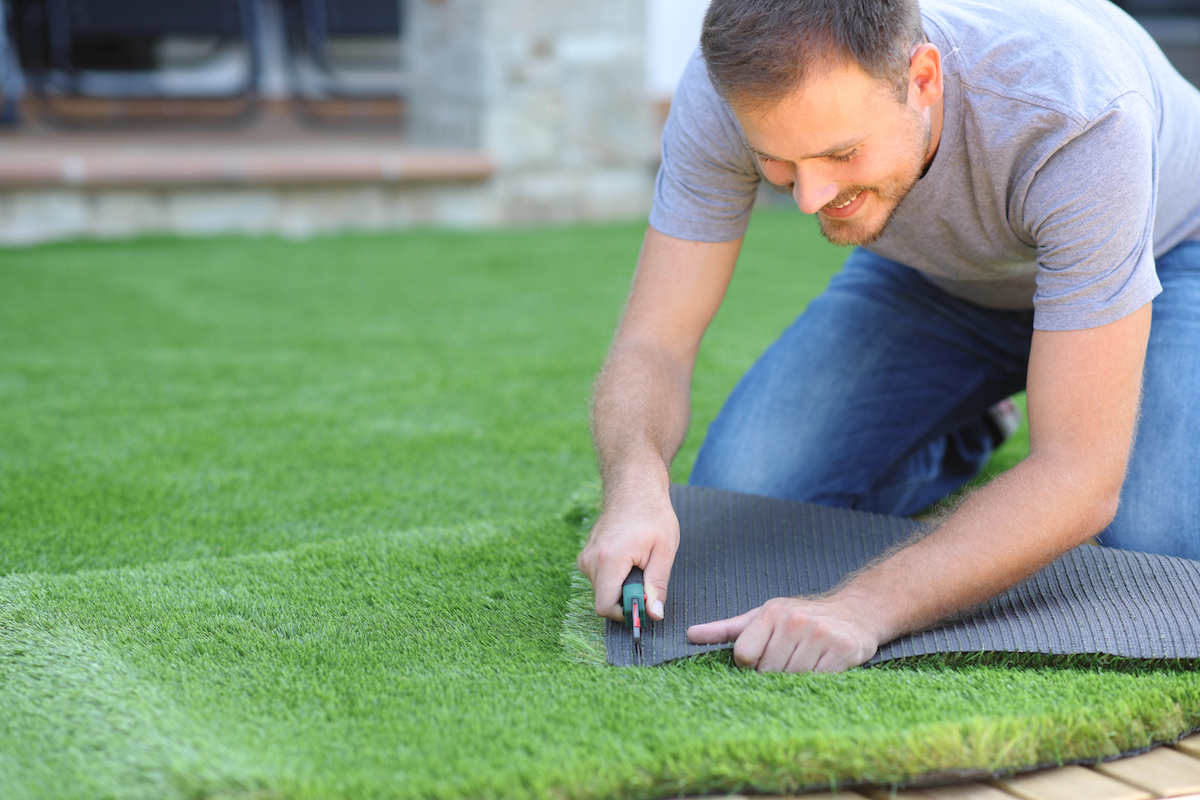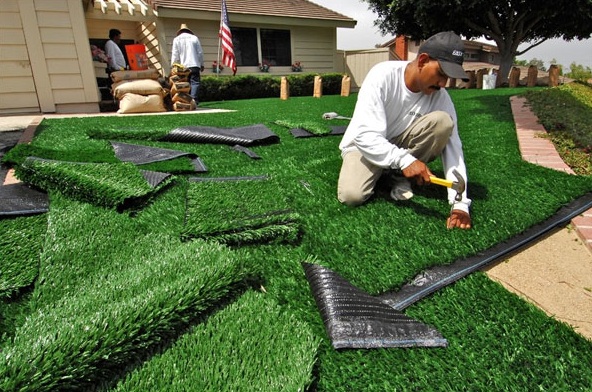Leading Phoenix Turf Companies Delivering High-End Synthetic Lawn Products
Leading Phoenix Turf Companies Delivering High-End Synthetic Lawn Products
Blog Article
See Why Homeowners Prefer Artificial Turf for Sustainable Landscaping Practices
As property owners significantly prioritize sustainability in landscaping, synthetic grass has actually become an engaging option to conventional yard. Its capacity to conserve water, minimize maintenance efforts, and decrease ecological effect positions it as a useful option for those looking for environmentally friendly remedies. The aesthetic charm and adaptability of man-made grass cater to varied design choices. However, the effects of this shift expand past plain convenience and aesthetics, motivating a closer assessment of exactly how these options influence broader ecological end results. What continues to be to be discovered is the full extent of benefits that fabricated lawn can use to homeowners and the environment alike.
Water Preservation Perks
Among one of the most substantial benefits of synthetic grass is its role in water conservation. Standard yard yards require considerable amounts of water to preserve their lush appearance, commonly leading to overuse of neighborhood water resources, particularly in deserts. On the other hand, synthetic grass eliminates this need entirely, as it does not need watering. This not only preserves water but additionally minimizes the stress on metropolitan water systems, specifically during drought problems.
Furthermore, the installation of artificial grass can add to a much more sustainable landscape. House owners can significantly reduce their water costs, permitting reallocation of sources to various other environmental efforts or house uses. In addition, synthetic grass is developed to withstand different climatic conditions without the need for supplemental watering, making it a suitable option for regions encountering water scarcity.
The environmental benefits extend past instant water financial savings. By decreasing water intake, fabricated grass helps to mitigate the influences of climate change, maintaining important ecosystems that are threatened by too much water removal. As lasting landscape design practices acquire traction, synthetic grass arises as an accountable choice for home owners looking for to develop eco-friendly exterior areas.
Reduced Maintenance Initiatives
Synthetic grass significantly decreases upkeep efforts compared to traditional grass lawns. With artificial turf, home owners can eliminate the taxing jobs related to natural landscaping, such as mowing, fertilizing, and weeding. This not just conserves beneficial time yet also decreases physical labor, making yard care accessible for people of any ages.
Conventional lawns call for constant cutting to maintain a visually pleasing elevation, whereas fabricated turf continues to be constantly lush without the need for cutting. Additionally, property owners no longer need to use chemicals or plant foods, which are commonly required to keep natural turf healthy.
Additionally, synthetic grass is long lasting and resistant, calling for very little upkeep beyond occasional cleaning and washing to remove debris. This ease of upkeep allows house owners to enjoy their outside areas without the constant concern of upkeep, offering more time for recreation and household activities. Ultimately, the decreased upkeep efforts associated with fabricated turf make it an appealing option for those looking for a low-maintenance, visually appealing landscape.

Environmental Influence Decrease
There is an expanding recognition of the ecological benefits connected with synthetic grass, especially in regards to water conservation and lowered chemical usage. Standard yards call for significant quantities of water, especially in drought-prone regions, leading to boosted pressure on local water sources. On look these up the other hand, man-made lawn eliminates the requirement for watering, substantially decreasing water usage and advertising sustainability.
Additionally, standard grass upkeep frequently includes the application of pesticides, fertilizers, and herbicides, which can contribute to soil and water pollution. Synthetic grass minimizes this ecological hazard by needing very little maintenance and essentially removing the demand for harmful chemicals. This not only enhances soil health and wellness but also safeguards regional communities from hazardous overflow.
Moreover, the production of natural turf yards commonly entails the use of nonrenewable fuel sources for cutting and landscape design equipment, additional adding to greenhouse gas discharges. By selecting synthetic grass, homeowners can significantly reduce their carbon impact connected with grass care activities.
Aesthetic Allure and Versatility
In enhancement to its environmental advantages, synthetic grass uses significant aesthetic charm and versatility for landscaping. House owners can achieve a lush, eco-friendly look year-round, eliminating the seasonal changes commonly connected with all-natural yard. This consistent aesthetic not just boosts the visual appeal of a property but likewise adds to a well-kept and refined look.
Additionally, fabricated turf is available in a range of shades, designs, and appearances, enabling personalization to match specific preferences and style motifs - Arizona artificial turf. Whether made use of in residential yards, business areas, or leisure areas, it can seamlessly incorporate right into diverse landscaping layouts, from modern-day minimalist to lush exotic setups
The adaptability of synthetic grass expands past mere look; it can be set up in various areas, consisting of rooftops, patios, and also interior spaces, creating possibilities for one-of-a-kind landscape design options. Furthermore, it appropriates for a variety of tasks, from youngsters's backyard to pet-friendly atmospheres, offering functionality without endangering design.
Eventually, the aesthetic charm and adaptability of artificial lawn make it an eye-catching option for house owners seeking lasting landscaping solutions that do not compromise beauty for ecological responsibility.

Long-Term Expense Cost Savings
One of one of the most engaging advantages of synthetic grass is its capacity for lasting cost savings. Unlike natural yard, which requires normal maintenance-- including mowing, watering, feeding, and insect control-- synthetic grass dramatically minimizes these ongoing costs. Homeowners can conserve a substantial amount on water bills, particularly in areas where water scarcity is a pressing concern. The removal of lawn care solutions better adds to economic cost savings, as there is no requirement for specialized equipment or labor.
Furthermore, synthetic grass has a life-span of 15 to 25 years, relying on its top quality and use. This sturdiness decreases substitute prices, making it click here for more info an extra economical selection in the future. Moreover, the initial financial investment in synthetic grass can commonly be recouped with the savings accrued with time.
While the in advance expense may appear higher compared to turf setup, the advancing savings from lowered upkeep and water usage frequently outweigh these first expenses. Ultimately, the fostering of synthetic grass not only advertises a sustainable landscaping remedy yet likewise provides homeowners a financially wise alternative that lines up with long-term budgeting objectives.
Final Thought
Man-made grass arises as an engaging option for sustainable landscaping, supplying significant advantages in water click here for more conservation, minimized upkeep initiatives, and lessened ecological impact. As neighborhoods significantly prioritize environmentally friendly techniques, the fostering of artificial grass represents a modern action towards achieving resilient and sustainable landscapes.
Furthermore, man-made lawn is made to withstand different climatic conditions without the requirement for extra watering, making it an excellent selection for areas encountering water deficiency. (Artificial turf companies phoenix)

Synthetic grass emerges as a compelling option for sustainable landscaping, supplying substantial benefits in water conservation, decreased upkeep initiatives, and diminished ecological influence.
Report this page